Tag: soup
October 3
I started my Monday by listening to Blood Orange until my ears fell off, which was nice. Then my friend Jenny told me to watch this (old-news) video (that I somehow had never seen before), and with that, my week is off and running. Hi to you.
Now, business:
1. The Guardian kindly invited me to write about a food that evokes home, and I wrote about a dead-simple, bare-cupboard soup that was first made for me by my aunt Tina. That’s her below, on the right, living the early-eighties hot tub life with me and my cousins. Most people thinks that June gets her hair color and texture from Brandon, but world, let it be known that I think she’s got my texture and my mom’s/Tina’s color. I have spoken.

The story came out on Saturday, and you can read it over at the Guardian. I’m also including the recipe below, because it’s exactly the kind of everyday cooking I love to do, and I think you might feel the same way. It makes me sad to think of not having the recipe in the index of this site. So go get ‘er.
2. In other news, my friend Christophe sent me a link to an evocative BBC story on the late American musician Arthur Russell, whose work haunts me. If you haven’t yet heard him, “A Little Lost” will really do it for you.
3. Last, Dino’s is hosting a very worthy fundraiser tonight, October 3, for Jubilee Women’s Center. If you’re up for some carrying-on and dancing on a Monday night, we hope you will join us. The party starts at 8:00 and goes until 2 am, and I’m really hoping that my mom is game to June-sit, hi Mom, because I would like to go do some dancing. You can find more information here, and if you can’t make it, you can always donate to Jubilee directly.
xx
Charlie Brigham Soup
Charlie Brigham, Blanca, Tina Baylis, and Sarah Connolly
Charlie Brigham used Swanson canned chicken broth, fideo vermicelli, egg, and Kraft parmesan cheese – the green‑canister kind that keeps for a small eternity. Today, you might swap in organic chicken broth (homemade or not), capellini and freshly grated parmesan.
Crack the egg into a small bowl, and beat well.
In a small saucepan, bring the broth to a boil. Add the pasta, and cook according to package directions, until just tender. Drizzle in the beaten egg, stirring constantly with a fork so that the egg breaks into feather-like pieces rather than clumps.
Divide the soup between two wide, shallow bowls. Top with grated cheese and black pepper. Serve with a fork, for twirling noodles, and a spoon.
Yield: 2 (light) servings
That January thing
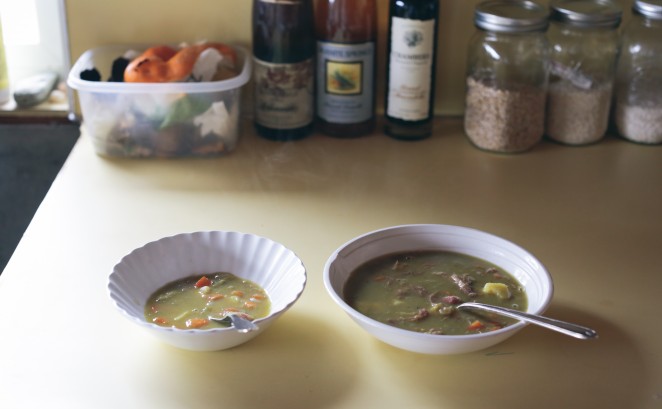
Split pea, the ugliest soup! The food whose appearance most closely approximates toxic waste water! The miraculous substance capable of making a home kitchen feel like a military chow hall! Capable of making a person who has never used the words “chow hall” in her entire life suddenly feel like Chow Hall is what she will call her vast, sweeping estate in the English countryside, when she somehow inherits a vast, sweeping estate in the English countryside! Split pea, a voyage for the mind! I have written before about split pea soup. It is apparently a January thing for me: I last wrote about it four years ago this month. Until yesterday, in fact, I wasn’t going to write about this particular version,…
Read morePlease consider
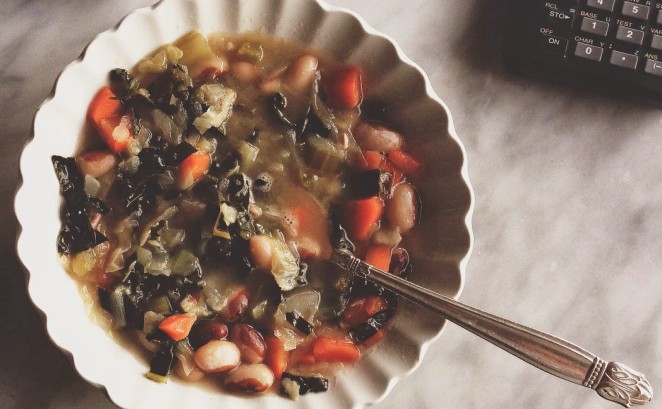
So, how bored will you be if we talk about soup again? Ham Bone, Greens, and Bean Soup? I didn’t set out to write about this one – I made it mostly as a vehicle for a ham bone that I put in our freezer last April, forgot, and then triumphantly unearthed the week before last – but June liked it so much that she did her special high chair “dance,” swaying from side to side and grunting, so I changed my mind. Swaying and grunting: strong praise from young June E. A. Pettit! (Also, Swaying and Grunting: what I will call my debut album when I launch my third career as a down-and-out country singer.) I know that it’s almost…
Read moreBut the soup
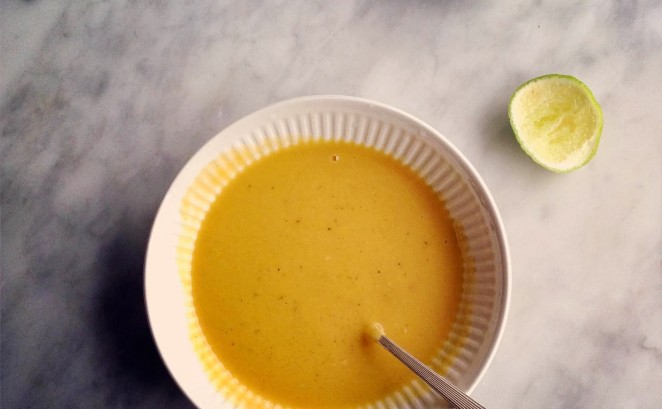
Would you look at that! While trying, and failing, to start this post about squash soup, I accidentally ate an entire chocolate chip cookie dough ball from the Delancey walk-in! Let’s get right to it. I’ve been wanting to tell you about this soup for more than a week now, but a certain crazy-haired dancing maniac of a young person is getting a molar, or something, and has been waking up veeeerrrrrry early and then spending a large portion of the day crawl-running around the house/park/bathtub/Delancey, panting, grunting, and generally looking and acting a lot like Animal. After she goes to bed, I make myself a drink, warm up some soup, open a book, close the book, and sleep like a dead person.…
Read moreIt’s my specialty
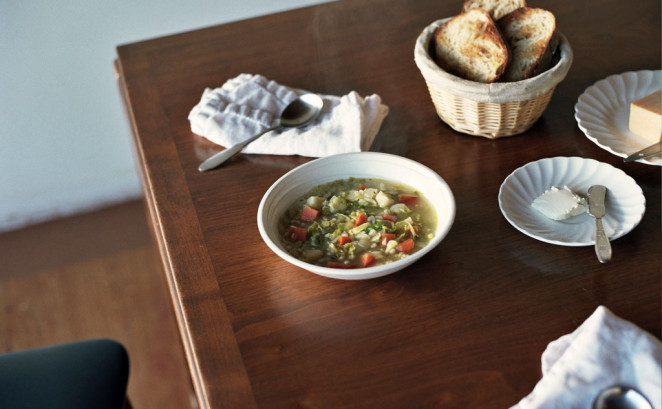
Hi. I am writing this from my in-laws’ kitchen. Brandon is out on a bike ride with his dad. THEY’RE BOTH WEARING SPANDEX!!!! It’s a great day to be in New Jersey. Before the holiday sets in, while it’s still relatively quiet in the house, I wanted to share a recipe with you. I should say first that it’s not for Thanksgiving. I know you already have plenty of that. What we have here is something for this weekend, or next week. More specifically, what we have here is the soup that I will be eating over and over and over again, lunch after lunch and dinner after dinner, for months to come. The New Winter Favorite. I can tell…
Read moreI am celebrating

2010 didn’t exit quietly, and the last month of it was a royal mess. But my aunt is okay now – even heading back to work! The rewards of health! – and for that, we’re relieved. I’m home again and excited for a new year, for the return of plain, normal, everyday life. I love plain, normal, everyday life. The laundry, the occasional clean sheets, the morning coffee that I never brew right, the dog asleep on the couch, the arrival of the mail, the mail carrier who hates the dog, the restaurant, the work, the split pea soup. Few things are uglier than split pea soup, but that is alright with me. I’ve been on something of a split…
Read moreA quiet soup
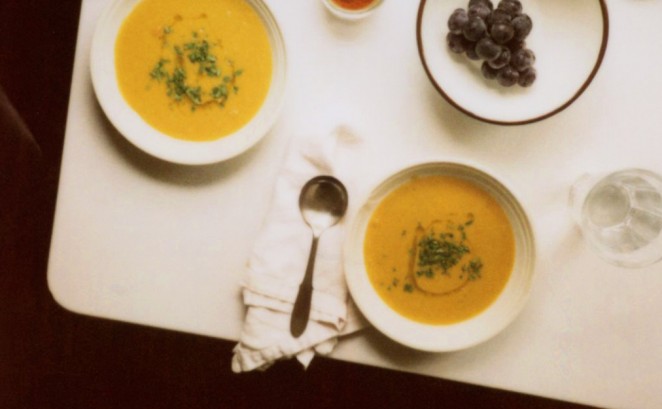
That was not the week I planned to have. Whoa. A week ago yesterday, I went to bed like I do every night. I read “Shouts & Murmurs” in the New Yorker and wondered, as usual, why it wasn’t very funny. I set my glasses on top of the stack of books on my bedside table and then retrieved them when they fell, as usual, and slid behind the table. I felt pretty normal – which is to say, I didn’t feel abnormal. Until I woke up at 3:30 in the morning, feeling nauseous, and spent the next four days on the couch, trying to get down a glass of Gatorade. You know you’re very sick when even a nature…
Read moreNow you know
I have a confession to make. It probably seems like I live and breathe to cook, right? It probably seems like I never get tired of stirring and whisking and chopping, like I go to sleep at night spooning the refrigerator and wake up each morning to find a skillet under my pillow and a rainbow arcing gently, benevolently, over the stove. But the truth is, there are many days when I would rather do anything than cook. ANYTHING. Like, hit-myself-over-the-head-with-the-aforementioned-skillet anything. Anything. Lately, I’ve been having a lot of those days. At first, I thought it was because of my recent run of bad recipes. It’s hard to feel terribly excited about spending time in the kitchen after you’ve…
Read more
